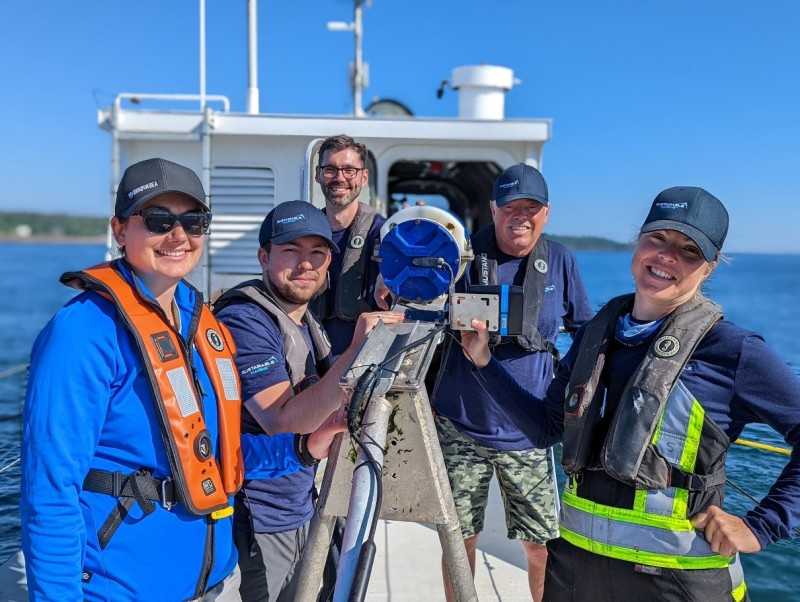Sustainable Marine engages Canadian specialists to enhance tidal energy environmental monitoring

Sustainable Marine has engaged a series of Canadian specialists to further support its environmental monitoring efforts, regarded as one of the most ambitious and advanced ever delivered in the tidal energy sector.
In May, the marine energy pioneer became the first firm to successfully convert floating in-stream tidal power to Canada’s grid, after harnessing the enormous tidal currents in Nova Scotia’s Bay of Fundy.
The firm’s in-stream technology differs from traditional tidal energy systems, including barrages, with the electrical generators installed directly into the tidal stream. This means there is no blockage to the water passage from large structures, greatly reducing impact to the surrounding environment and marine life.
With the support of fish tracking experts Innovasea, Sustainable Marine is now trialling advanced techniques that could further enhance knowledge of the marine ecosystem - including fish tag triangulation, tests of close-range high-resolution imaging sonar and exploration of artificial intelligence techniques for video processing. The company is also working with a series of other local Canadian specialists including SubC Imaging to test advanced video cameras to enhance image quality.
This new tranche of work builds on Sustainable Marine’s extensive environmental monitoring efforts previously carried out under the Ocean Energy Research Association’s Pathway project to test imaging sonar, surface and bottom mounted echosounders and to automate reporting of data.
“We are pleased to be working with Innovasea, SubC Imaging and a number of other Canadian specialists who bring unparalleled knowledge and expertise,” said Sustainable Marine CEO Jason Hayman. “The work we are undertaking will shed further light on fish behaviour by determining the location of tagged fish and their proximity or otherwise to our tidal energy platform. We have trialled imaging sonar before but want to see how well high-resolution sonar performs in close proximity as one of the options being explored to support 24-hour monitoring and operation. Artificial Intelligence techniques are also being used to assess video data and automate analysis. This will all inform ongoing work as we continue building a robust risk assessment methodology, taking into account fish behaviour and distribution as well as the physical properties of turbines, to demonstrate the low impact status of our tidal technology.”
Innovasea President Mark Jollymore said: “Sustainable Marine is doing some ground-breaking work on the green energy front and we’re excited to be lending our technological expertise in acoustic telemetry and fish tracking to enhance its environmental monitoring initiatives and help protect natural ecosystems.”
Sustainable Marine has been performing extensive environmental monitoring in the Bay of Fundy since 2018, resulting in more than 2,000 hours of video (comprising many tens of terabytes of data). Results show few positive identifications of marine life, other than at slack tide when rotors are stationary.
Large volumes of data continue to be collected through Sustainable Marine’s multi-sensor environmental monitoring system, which is attached to the PLAT-I 6.4 platform. The custom-built system comprises of seven hydrodynamic daggerboards onto which a number of instruments can be mounted and simultaneously deployed, using a variety of techniques to record marine life in the vicinity of the platform. These instruments include underwater cameras, hydrophones, echosounders, marine mammal click detectors and acoustic fish tag receivers. Operated through moonpools, the innovative system can be easily accessed above the water surface, before being lowered to a fixed depth. A separate data acquisition system captures, stores and streams material, which can be accessed remotely onshore.
“We have now compiled a number of monitoring reports, produced on a quarterly basis,” added Hayman. “Our findings are consistent with all other studies which have been completed over the last 15 years involving the deployment and operation of in-stream turbines around the world, that have to date observed no negative interactions or harm to marine life. More specifically, our hydrophone data has identified low amounts of turbine noise, and neither hearing injury nor significant behavioural disturbance of fish is expected based on the measured sound levels. Meanwhile, in the 14 months of deployment, fish tag receivers have detected six animals, likely to be great white sharks, with no other marine mammals or fish species identified in the vicinity of the platform.”
Sustainable Marine is also contributing to FORCE’s (Fundy Ocean Research Center for Energy) Risk Assessment Program (RAP) by supporting a fish tagging campaign in the Minas Passage. The RAP project is building a map of likelihood of the different species of fish being present at various locations in Minas Passage at different states of tide and over the seasons and the likelihood of this overlapping with deployment locations of in-stream tidal turbines. Present results summarized in FORCE’s RAP Annual Report 2022 indicate that at slower current tide stages, fish in the passage are able to spread out in the relatively slow, calm water but as current speeds pick up fish tend to move closer to shore and into sheltered areas such as West Bay.
